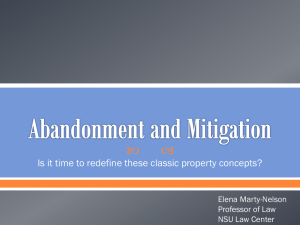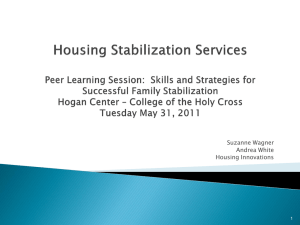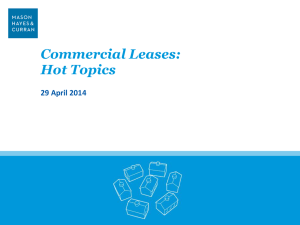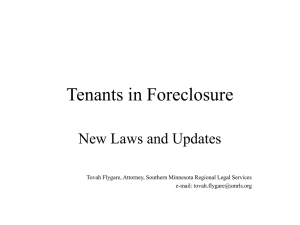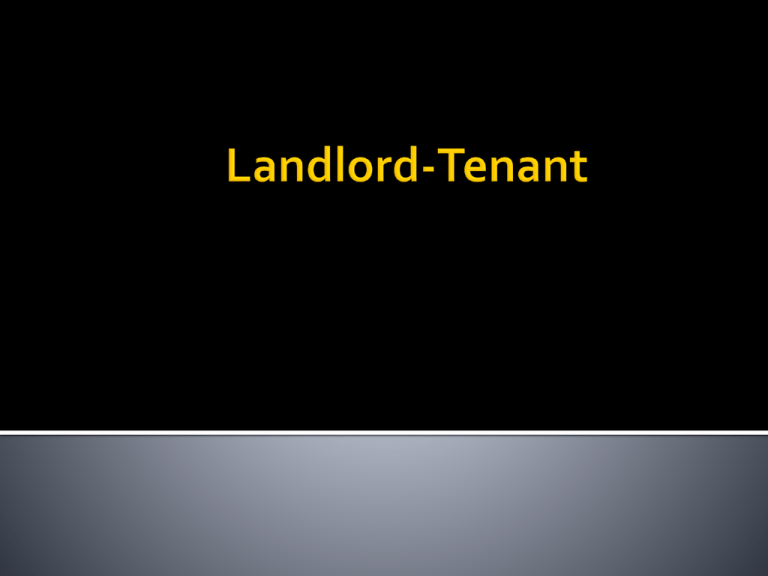
Owner (landlord; lessor) conveys right to
occupy (lease) to a tenant (lessee) for a certain
period of time.
Owner retains a reversion.
Historically, a lease transformed from being a
pure conveyance to being a hybrid of a
conveyance and a contract.
Under modern law, highly regulated by
statute, especially if residential.
1. Tenancy for a term (also called “estate
for years” or “term for years”)
Automatically ends when time elapses.
E.g., a one year lease, a nine month lease, a
99 year lease.
2. Periodic Tenancy
Fixed term which renews automatically unless
steps are taken to terminate.
“month-to-month” “year-to-year”
3. Tenancy at Will
No definite term
Continues until either party terminates
4. Tenancy at Sufferance
The “hold over” tenant.
[Not
actual
property]
Statute of Frauds (1677)
If over three years, must be in writing.
Modern Law
If over one year, must be in writing (Texas).
All leases must be in writing.
1335.04 Interest in land to be granted in
writing.
No lease, estate, or interest, either of freehold
or term of years, * * * shall be assigned or
granted except by deed, or note in writing,
signed by the party assigning or granting it, or
his agent thereunto lawfully authorized * **.
Common law = landlord could exclude
anyone for any or no reason.
Contrast with innkeeper rule.
Modern law = restricted by federal, state,
and local law
Cannot discriminate based on:
Race
Color
Religion
Sex
Family status (pregnant or having children)
National origin
Handicap
NORTHLAKE deluxe 1 BR apt, a/c, newer
quiet bldg, pool, prkg, mature person
preferred, credit checked. $395 . . . .
Lease transfers a present possessory estate
to the tenant.
But, landlord has right to protect the
landlord’s reversion from waste.
If tenant cannot possess because a third
party is in unauthorized possession when
lease starts, what happens?
1. American View
Landlord’s duty is to deliver legal possession.
Thus, tenant must remove unauthorized
occupier.
Minority approach in U.S.
2. English View
Landlord’s duty is to deliver actual (not just
legal) possession.
Thus, landlord must remove unauthorized
occupier.
Majority approach in U.S.
3. Lease Terms
Study lease to see if it expressly deals with this
issue.
State law may require residential landlords to
place tenant in actual possession regardless of
lease terms.
Possession disrupted by third party after
tenant has possession.
General rule is that this is tenant’s problem.
Landlord’s options for treating former
tenant:
Trespasser and evict.
Periodic tenant.
Lease was a conveyance.
Landlord not responsible for condition of
premises.
Tenant had duty to protect landlord’s
reversion and not commit waste.
Value of lease was the use of the land itself
(farming), not the buildings.
Landlord’s duties
Not misrepresent condition
Reveal known undiscoverable hidden defects
Independent covenants
Implied Warranty of Habitability
Primarily for residential tenancies
By court judgment
By legislation
Kamarath v. Bennett, 568 S.W.2d 658 (Tex.
1978).
“[A]t the inception of the rental lease, there are
no latent defects in the facilities that are vital to
the use of the premises for residential purposes
and that these essential facilities will remain in
a condition which makes the property livable.”
Enactment in 1979 of Property Code
§ 92.052
Abrogated Kamarath implied warranty.
Created limited duty of landlord to repair.
Davidow v. Inwood North Professional
Group-Phase-I, 747 S.W.2d 373 (Tex. 1988).
Implied warranty of suitability by landlord in
commercial lease that premises suitable for
their intended commercial purposes.
Does tenant need to continue to pay rent
even though the government has taken the
property?
Warning: Highly regulated by state law.
Withhold rent
Repair and deduct
Sue for damages
Treat as constructive eviction and move out
In most situations, the tenant is at fault
and has been very destructive to the
building.
1. Agreement between landlord and tenant
(free market)
2. Limited by government (rent control)
Silent lease = any legal use
Lease indicates use = precatory; not a
limitation (unless residential)
Lease restricts use = only the allowed use
Common Law
Unless lease provision, tenant does not forfeit
lease
Modern Law
Tenant forfeits lease (also, forfeiture typically
provided by lease provision)
Tenant has duties (similar to a life tenant)
not to commit voluntary or involuntary
waste.
Note interface with implied warranty of
habitability.
If fixture, tenant may remove and take.
No substantial damage.
Repair (or pay for) all damage.
If improvement, stays with property.
Issue = Has personal property morphed all
the way to real property?
Landlord not responsible unless:
Landlord not responsible unless:
Fail to disclose known latent defects
Landlord not responsible unless:
Fail to disclose known latent defects
Leased for admission of public
Landlord not responsible unless:
Fail to disclose known latent defects
Leased for admission of public
Short-term lease of furnished dwellings
Landlord not responsible unless:
Fail to disclose known latent defects
Leased for admission of public
Short-term lease of furnished dwellings
Breach of express covenant to repair
Landlord not responsible unless:
Fail to disclose known latent defects
Leased for admission of public
Short-term lease of furnished dwellings
Breach of express covenant to repair
Negligence in making repairs
Landlord not responsible unless:
Fail to disclose known latent defects
Leased for admission of public
Short-term lease of furnished dwellings
Breach of express covenant to repair
Negligence in making repairs
Injury in common area under landlord’s control
Landlord not responsible unless:
Fail to disclose known latent defects
Leased for admission of public
Short-term lease of furnished dwellings
Breach of express covenant to repair
Negligence in making repairs
Injury in common area under landlord’s control
Breach of statutory duty to repair
Movement to adopt tort-based rule of
reasonable care and foreseeability.
Traditional rule = no duty
Modern rule = Was landlord negligent?
1. Terminate lease
1. Terminate lease
2. Sue for damages
1. Terminate lease
2. Sue for damages
3. Retain part or all of security deposit
1.
2.
3.
4.
Terminate lease
Sue for damages
Retain part or all of security deposit
Evict
1.
2.
3.
4.
5.
Terminate lease
Sue for damages
Retain part or all of security deposit
Evict
Use landlord’s lien on contents
Before 1381
Force allowed as long as no serious injury or
death resulted.
1381 Statute of Forcible Entry
Self-help eviction still allowed but must be
peaceful.
Forcible entry not allowed.
Modern law
Heavily regulated by statute.
Often long and costly procedures before
landlord can have authorities remove a tenant.
Some states prevent landlord from denying
services even to non-paying tenant.
Forcible detainer (“change locks”) may be
prohibited, even if peaceful.
Landlord takes action (e.g., evict, raise
rent, terminate lease) to “get even” with
tenant who asserts rights.
Texas = Prohibited under Property Code
§ § 92.331-.335.
Landlord may transfer the reversion (aka,
sell the property).
Common law concept of “attornment”
requiring the landlord to obtain the
tenant’s consent is generally abolished
(England = 1705).
May landlord limit?
Commonly restricted by lease.
Courts normally uphold restriction but strictly
construed.
But, growing trend to prevent landlord from
withholding consent in an unreasonable manner.
But, also growing trend to require landlord’s
express consent even if lease silent.
Texas Property Code § 91.005.
“During the term of a lease, the tenant may not
rent the leasehold to any other person without
the prior consent of the landlord.”
Enacted in 1983 and never amended.
Tenant transfers entire interest to assignee.
“substitution” analogy
Assignee is now tenant of landlord and
they owe duties to each other.
But, original tenant still liable to landlord
under original terms of lease unless
landlord executes a release (not a mere
consent).
Tenant transfers less than entire interest to
subtenant.
“Subinfeudation” analogy
Subtenant’s duties are to tenant, not
landlord.
Landlord’s duties are to tenant, not
subtenant.
Under given facts, may be difficult to
determine.
Modern trend is to treat all lease transfers
as assignments.



